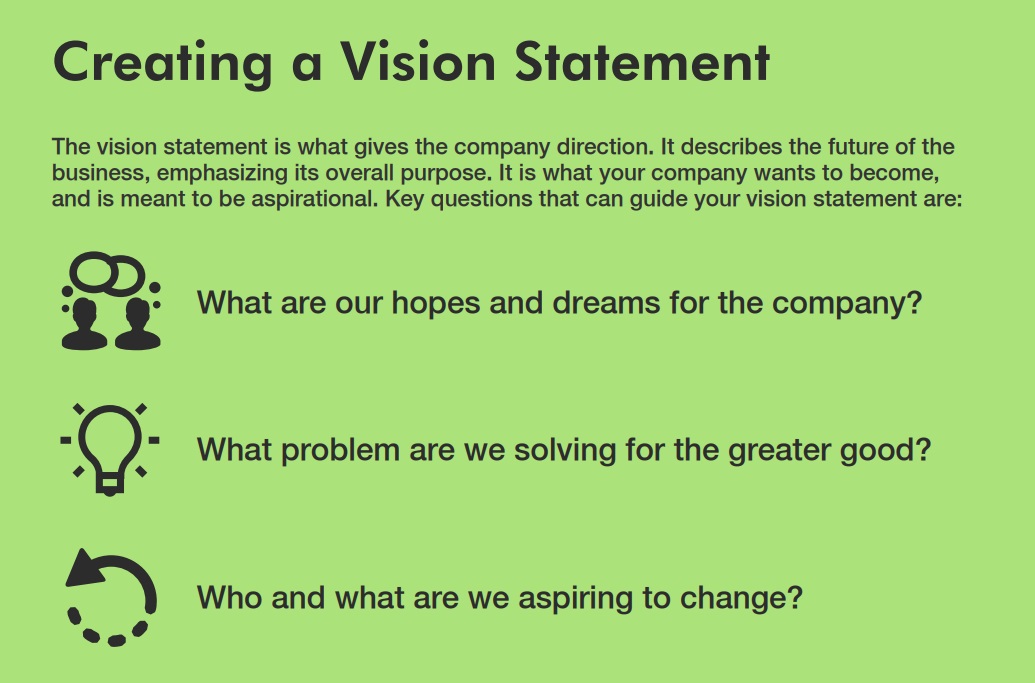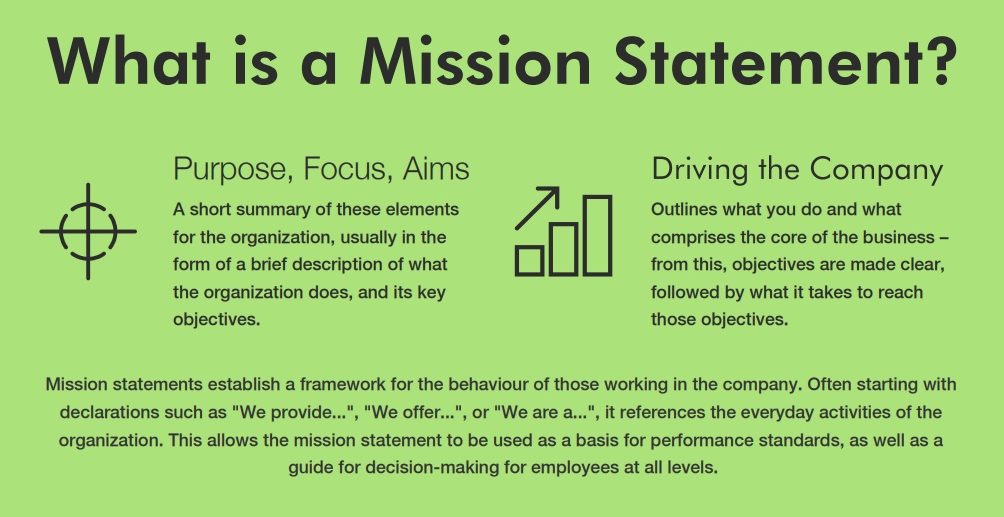
The Difference Between Mission and Vision Statements
Just like people, companies need not only a direction, but a clear idea of what the goals are and how to go about achieving them. In addition to this, an organization’s employees need a sense of cohesiveness in order to collaborate in harmony and work towards the shared goal of the company. These central pillars of effective organizations are encapsulated by mission and vision statements. It is for this reason that it is important to understand the difference between mission and vision statements.
A vision statement focuses on tomorrow and what an organization ultimately wants to become. A mission statement focuses on today and what an organization does to achieve it. However, the lines often get blurred between the two. When it comes to driving and directing your company both today and tomorrow, you must be able to break down the difference between mission and vision statements so you can better understand and define your company’s essence with confidence.
What is a Mission Statement?
A mission statement is a short summary of an organization’s core purpose, focus, and aims. This usually is comprised of a brief description of what the organization does and its key objectives. It often takes shape as a declaration of what an organization does every day, defining the day-to-day activities of work, and each person who works for the organization contributes to that overall mission.
The mission statement drives the company. It outlines both what you do and what comprises the core of the business, and from this, objectives are made clear, followed finally by what it takes to reach those objectives. A strong mission statement is one that motivates a team to consistently advance toward a common goal. Questions that guide mission statements include:
- What do we do?
- Whom do we serve?
- How do we serve them?
Mission statements establish a framework for the behaviour of those working in the company, often starting with declarations such as, “We provide…”, “We offer…”, or “We are a…”. Because of its reference to the everyday activities of the company, missions statements can often be used as a basis for performance standards, and can guide employees at various levels of the company in their decision-making.
What is a Vision Statement?
A vision statement is a short description of an organization’s aspirations and the wider impact it aims to create. It acts as a guiding beacon to those within the organization, as well as something that sets the ground for internal decision-making and determines the intended direction of the organization. A vision statement is meant to be a clear, definitive statement of what an organization wants to accomplish, and what the world will look like once they have accomplished that mission.
The vision statement gives the company direction. Because it describes the future of the business, it emphasizes the organization’s overall purpose. The vision statement is about what you want to become – it is meant to be aspirational. Questions that guide vision statements include:
- What are our hopes and dreams for the company?
- What problem are we solving for the greater good?
- Who and what are we inspiring to change?
A vision statement is future-oriented, providing a sense of what the company values to both those inside the organization and outside of it. Oftentimes, a vision statement is used for public relations purposes. Because vision statements aim to encapsulate the overall strategic goals for a company, they tend to remain unchanged often. Every smaller organizational step is curated to be contributing to the effort in achieving the overall vision of the company. Because of its transcendent and directive nature, vision statements are often written in the present tense, but still serve the future of the organization.
Download our infographic to learn how to create an appropriate vision statement, mission statement and more!

Mission and Vision Statements
Send download link to:
The Difference Between Mission and Vision Statements
The central difference between mission and vision statements is the timeline it covers. Though there can be overlap, a mission statement tends to define what the organization is currently doing, while a vision statement is essentially the final goal of what they’d like to accomplish. In short, the mission is the what and the how, and the vision is the why.
Mission statements can be used for cohesive management, because it is mutable and changes when the circumstances or needs of the company shift. Because employees’ duties, actions, and behaviours all fall under the mission statement, it should be adaptable to changes in the organization. On the flip side, the vision statement is a goal that may or may not be elusive and is therefore not a particularly effective way to direct individual behaviour and expectations regarding day-to-day activities. Its purpose is more so to give employees an idea of what the organization hopes to eventually accomplish collaboratively.
While companies commonly use mission and vision statements interchangeably, it is important to have both. They are codependent because purpose (mission) and meaning (vision) are critical for the success of any business.
Inspiring Examples of Mission and Vision Statements
The mission statement inspires effective day-to-day activities, while the vision statement encourages growth, both internally and externally. Strong mission and vision statements invite innovation and hard work, and both envision and accomplish success in detail and on a larger scale.
Here are several companies that got it right and have the customer loyalty to prove it. Note the clear difference between mission and vision statements for each company.
Tesla
Mission Statement: To create the most compelling car company of the 21st century by driving the world’s transition to electric vehicles.
Vision Statement: To accelerate the world’s transition to sustainable energy.
Why it Works: Their mission statement clearly defines their core goal, then communicates how they intend to accomplish that goal (hint: look for directive words such as “by” to recognize this). Its vision statement uses clever diction to enliven their lofty aspiration and showcases their drive for sustainable energy and how that goal steers the organization.
Amazon
Mission Statement: We strive to offer our customers the lowest possible prices, the best available selection, and the utmost convenience.
Vision Statement: To be Earth’s most customer-centric company, where customers can find and discover anything they might want to buy online.
Why it Works: Amazon’s mission statement summarizes the three things that has driven the astronomical success of the company: low prices, a huge selection, and incredible convenience. All great mission statements shine a light on the values that bring success. It’s vision statement effectively brings all these elements together, communicating one unified goal.
Nike
Mission Statement: Create ground–breaking sports innovations, make our products sustainably, build a creative and diverse global team, and make a positive impact in communities where we live and work.
Vision Statement: Bring inspiration and innovation to every athlete* in the world.
*If you have a body, you are an athlete.
Why it Works: Their mission statement effectively summarizes what the company aims to do and how they aim to do it. It uses diction that outlines the company’s underlying values: innovation, sustainability, diversity, and community. It is the vision, however, that drives the success of these statements. While capturing the goal for Nike as a brand, it also stands up against body-shaming and is a powerful call for inclusion. Resultingly, their vision statement is transformed into a moving sentiment that resonates with all who read it.
TED
Mission Statement: Spread ideas.
Vision Statement: We believe passionately in the power of ideas to change attitudes, lives and, ultimately, the world.
Why it Works: With such a simple, highly focused mission statement, the TED (technology, education, and design) brand focuses all of their everyday efforts into two powerful words that have driven the company to become a global phenomenon. In their vision statement, they clearly outline what they hope to achieve on a grander scale with the efforts put forward by the organization on an everyday basis.
IKEA
Mission Statement: Offer a wide range of well-designed, functional home furnishing products at prices so low that as many people as possible will be able to afford them.
Vision Statement: To create a better everyday life for the many people.
Why it Works: IKEA’s mission statement is clear and to the point, using words that embody the attributes of functionality, affordability, and design that IKEA products have. Their vision statement focuses their mission statement onto one singular purpose, and both statements employ inclusive phrasing that emphasizes the organization’s commitment to being accessible.
SpriggHR
Check out our mission and vision statement on our About page!
Download our infographic to learn how to create an appropriate vision statement, mission statement and more!

Mission and Vision Statements
Send download link to:
Summary
When done right, the difference between mission and vision statements is apparent and both are powerful and important for your organization. They unify efforts, acting as a signpost that continually focuses everyone’s efforts on the things that truly matter to the company.
The key to strong mission and vision statements is clarity. A mission statement is the “what” and the “how”, and the vision statement is the “why”. When writing your statements, first consider the core values of your organization. Then, think about the wider impact you hope to have on the world through your products and customers.




